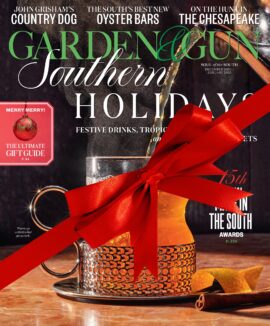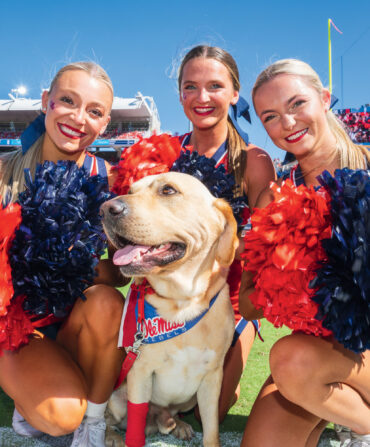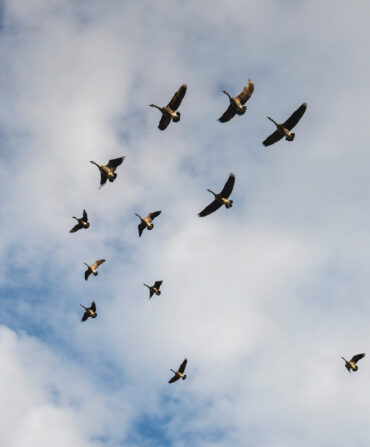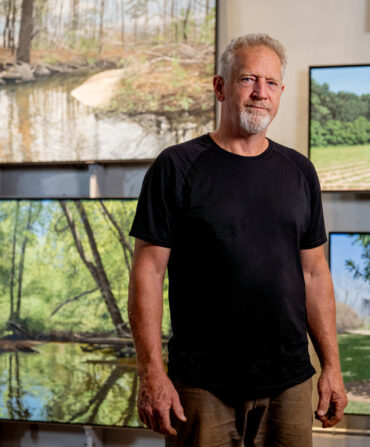Best of the Sporting South
The South’s Next Great Wildlife Artist
From his home base in the North Carolina mountains, Ryan Kirby is bringing an unbridled passion for the outdoors to the canvas—and giving the sporting art world a jolt of youthful energy
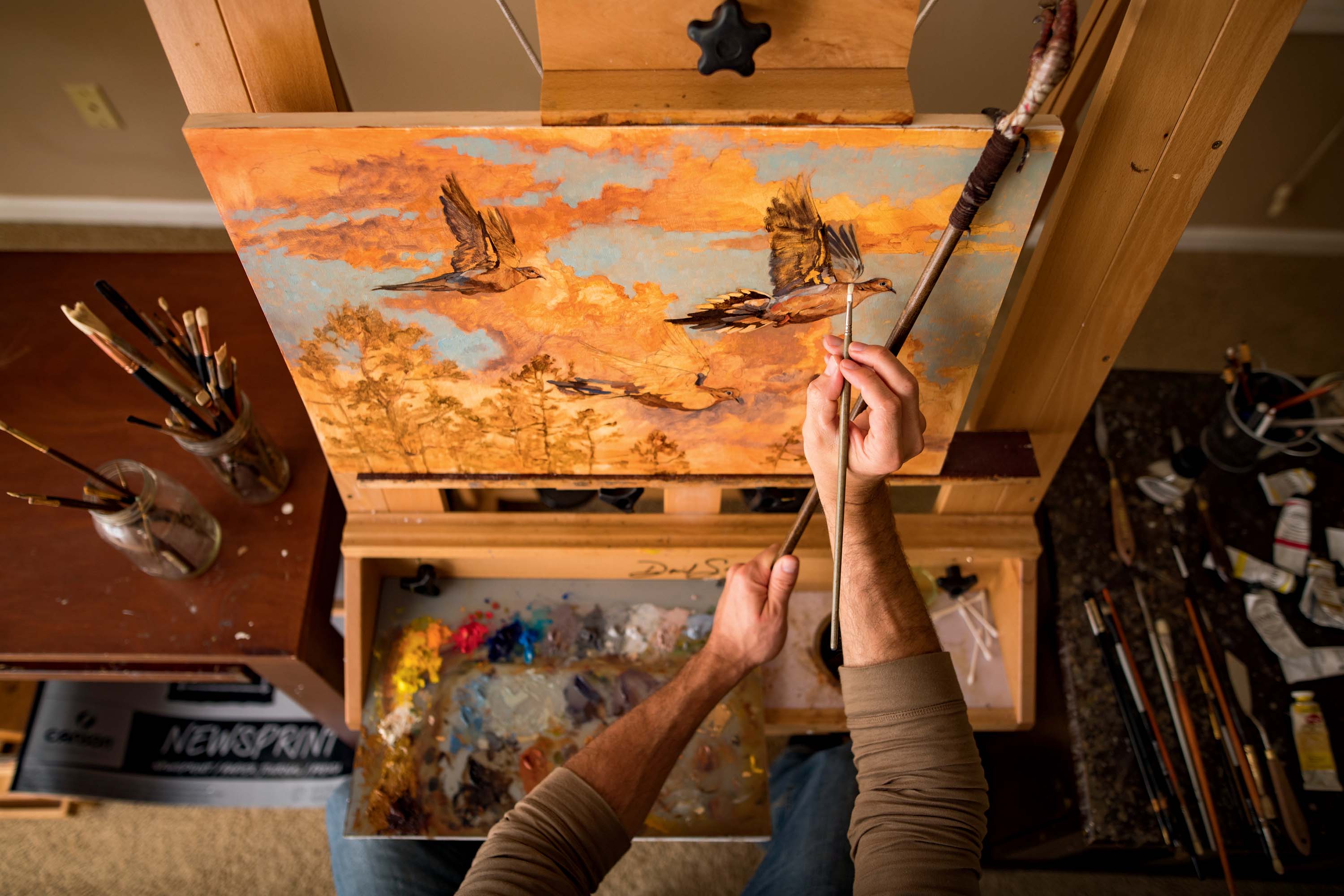
Photo: Andrew Kornylak
Ryan Kirby works on a painting of doves, Mourning Glory, at his home in Boone, North Carolina.
The hardest part, Ryan Kirby insists, is painting the animal’s foot—the cloven hoof of an elk or a deer, or the pebbly texture of a wild turkey’s tridactyl W. “No, really,” he says earnestly, aware that I’m not quite with him on this point.
“Painting an animal’s foot on the ground, with the right proportions, the balance, so the animal actually feels like it’s stepping and walking yet still connected.” He shakes his head. A big exhalation. “If I get the muscle structure just right, and the tendons and the highlights in the hair and all the angles, then that place where the foot meets the ground is the starting point in understanding how the animal relates to its environment.”
Much of a painting’s energy and meaning flow from that one spot on the canvas, he says. It is the nexus of the animate and the inanimate, a window into the relationship of a subject to the world it inhabits.
Which is a lot to think about when it comes to a turkey foot, but Kirby and I have been thinking about the connection of living creatures to landscape since an hour before the sun rose. We’d spent the morning chasing wild turkeys across a patchwork of pastures, crenellated wooded ridges, and steep mountains near Boone, North Carolina. The birds were late-in-the-spring quiet, and despite lung-busting climbs to call from remote ridgetops, we’d heard few replies. Now we’re kicked back in Kirby’s home studio tucked into a leafy neighborhood not far from the Appalachian State University campus, our camouflage pants still slicked with mud. The après-hunt conversation ranges from pointillism to the new barbecue joint in town to the growing role wildlife art plays in conservation funding.
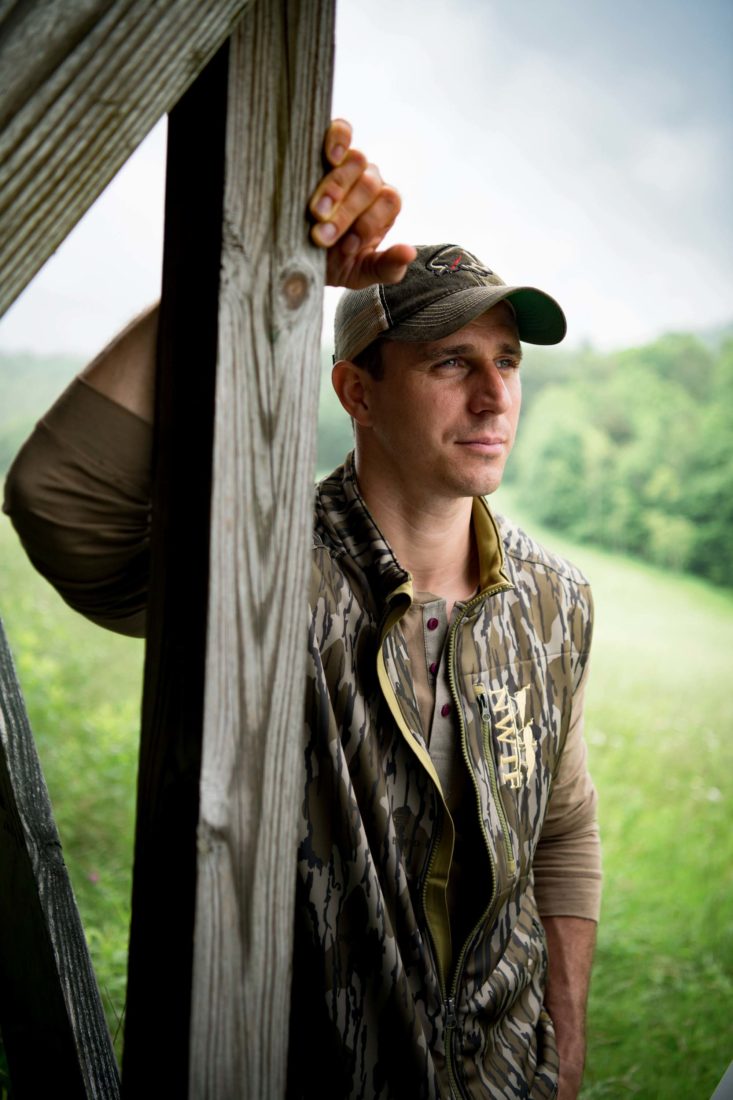
Photo: Andrew Kornylak
Kirby at a deer stand in “Bama Field,” a mountain pasture near his home where he hunts turkeys in the spring.
At one point, Kirby places me in front of a painting of a bugling elk, its urgent breeding scream caught in a horsetail of steam against dark timber. “Look at it while squinting,” he says. “You’ll see what I’m trying to do.” I narrow my eyes and let the painting go into soft focus. “Do you see?” he asks. “The things that have lesser contrast and meaning fall away, right? But close your eyes, and that bull elk will scream in your brain’s afterimage.”
That’s where he’s moving with his work, Kirby tells me, and there’s no sense of urgency now, no convincing tone. This is his private anthem: Let the energy, and the art, and his life, flow from the things that matter.
To say that Ryan Kirby is a rising star in the wildlife art world is an understatement. At the age of thirty-six he’s already amassed a roster of top-shelf commissions. Over the last few years, his work has been selected for the annual fund-raising art programs of organizations ranging from the National Wild Turkey Federation to the Rocky Mountain Elk Foundation. He’s painted five covers for Outdoor Life magazine, the first of which, in October 2014, was the title’s first illustrated cover in more than two decades. Kirby paints and illustrates for internationally renowned commercial clients such as Winchester and Browning, and his original oil paintings can fetch upwards of $10,000.
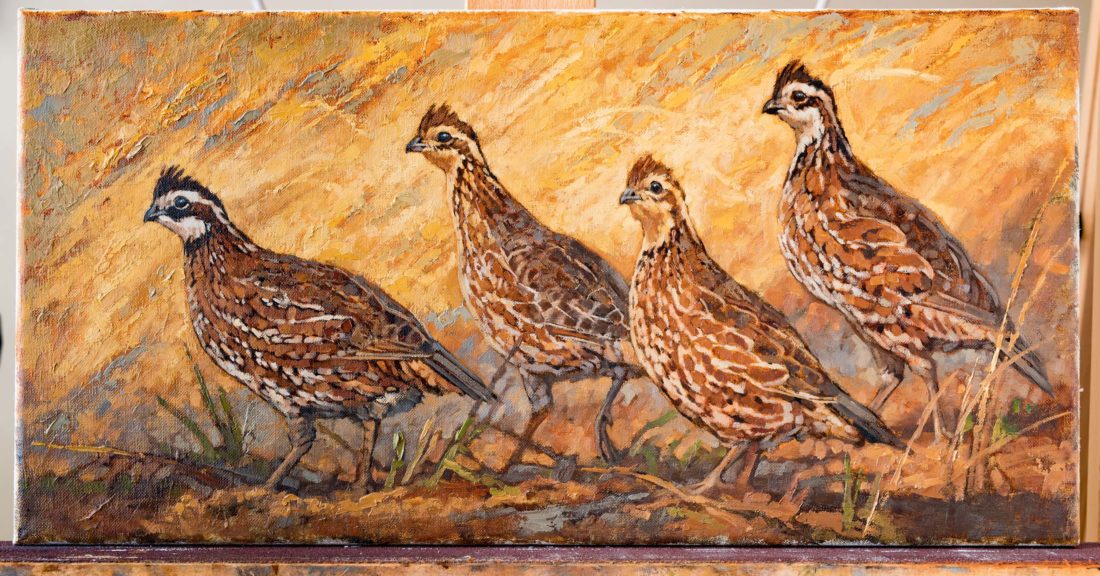
Follow the Leader, oil on board, 2017.
At the 2018 Southeastern Wildlife Exposition (SEWE) in Charleston, South Carolina—his fifth time invited to the annual sporting and conservation expo, the largest in the country—Kirby was the youngest artist in the show. In his exhibitions, elk, white-tailed deer, doves, and wild turkeys filled canvases with the kinds of scenes hunters recognize from their own experiences—or their dreams. “Ryan fills a gap left by older sporting life artists who lived to hunt and fish but aren’t as active as they used to be,” says Natalie Henderson, SEWE’s art curator. While there are plenty of wildlife artists, she says, “there are fewer who are painting really great sporting scenes. You can tell that Ryan’s work is based on authentic relationships with these animals and the places where they live. He’s living the lifestyle our collectors live, and that really shines through.”
Nor is Kirby content to live the cloistered life of an artist. He’s active on social media and acts as an ambassador for sporting art wherever he travels. During each of his SEWE visits, for example, Kirby has spoken to cadets at the Citadel, giving a multimedia presentation designed to inspire a new generation to pursue the outdoors and art.
Nearly six hundred of the Citadel’s cadets take fine-art classes each year, says Tiffany Silverman, the director of the college’s Fine Arts program, and many find a comrade in arms in Kirby. “We have a huge contingent of cadets who love the outdoors,” she says, “and Ryan speaks their language and is able to invite them into this other world of art that they’ve never thought about.”
Those kinds of efforts outside the studio underscore the younger, hipper vibe Kirby is bringing to the sporting art world, one he’s cultivating from a funky college town in the North Carolina Blue Ridge. Born and raised in western Illinois farm country, Kirby moved to Boone with his wife, Kim, in 2014, when she took a job as a university administrator. Boone takes rightful pride in the town’s hippie–academic–mud boggin’ mashup persona, as well as its status as an incubator for creative pursuits ranging from pottery to brewing. Kirby has adopted Boone as his spiritual and artistic homeland, but very few people have any inkling that the guy at the next table over holding his two-year-old son at the Pedalin’ Pig is painting some of the finest wildlife art in the country.
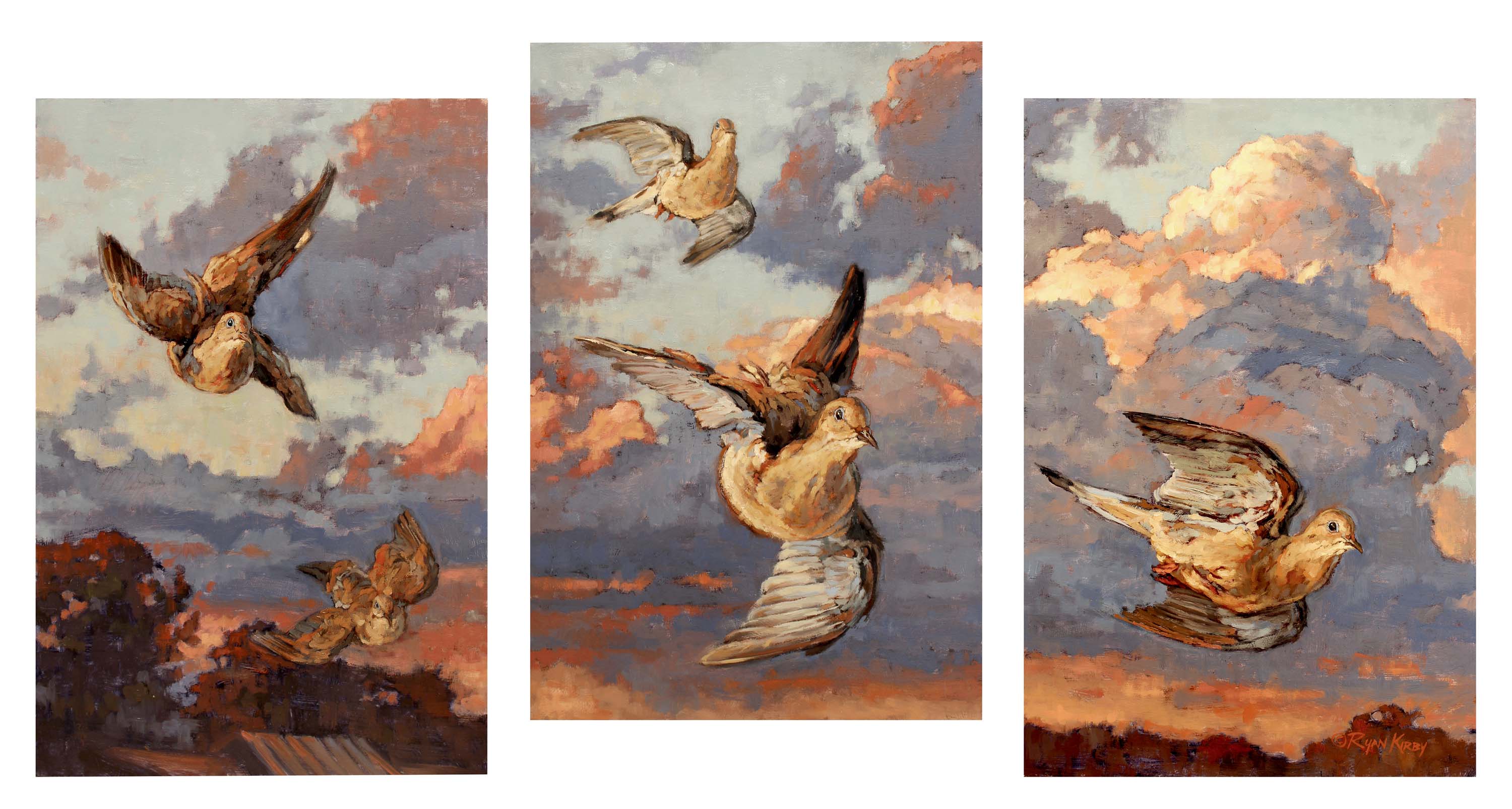
First Light Flight, oil on board, triptych, 2016.
Kirby grew up, he says, “about as blue collar as you can get,” on 120 acres of family farmland a mile east of the Mississippi River. His father grew corn, soybeans, and wheat; his mom was a postmaster. “I won’t say we were dirt-floor poor,” he says, laughing. “But there wasn’t a whole lot between us and the dirt. My dad let my brother and me tag along on the farm, but he didn’t let the farm bug bite us too deep.” Kirby was the first in his family to graduate from college.
Still, he took advantage of one of farming’s benefits: access to hunting and fishing. There were summers, Kirby says, during which he fished every day. Family photos show him holding bass while wearing his Little League uniform; he wouldn’t wait to change out of cleats before hitting the water. He was so in love with turkey hunting that he’d film the birds with a VHS camcorder long after the season had ended. Deer hunts, he remembers, were communal affairs, with twelve or fifteen men pushing through the woods. “Watching those men draw out deer drives in the dust on a truck hood, you could see how rural communities worked together,” Kirby says. “It’s the same way in these mountains now. People helping people. That’s why I say that I don’t love the South despite being from the Midwest. I love the South because I’m from the Midwest.”
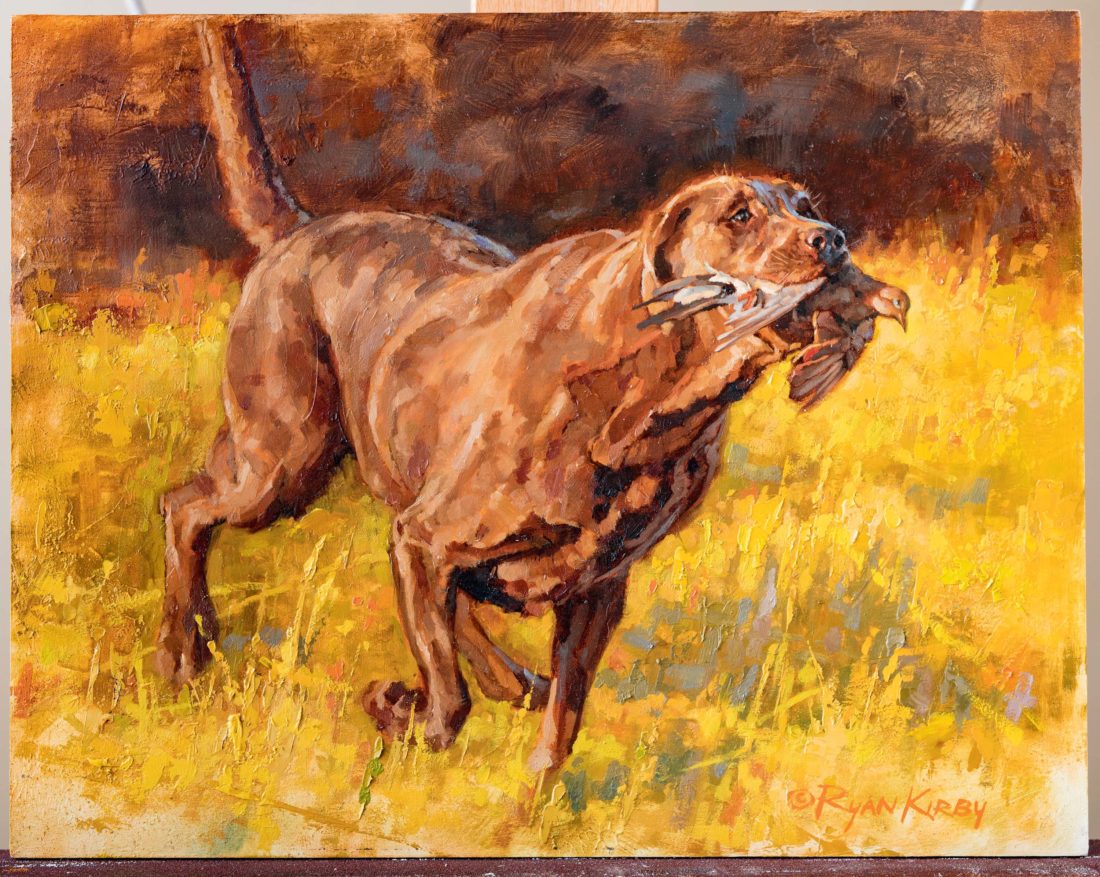
Labor of Love, oil on board, 2017.
His artistic abilities came to light early on. In middle school, when other kids were drawing stick figures and dogs with three legs, the art teacher would gather the class around Kirby’s desk. He was characteristically nonchalant about the attention. “At that stage in life,” he says, “I just thought: Some kids are good at kickball. I can draw a house. What’s the big deal?”
In high school, however, an art teacher had all his students paint under the guidelines of the Federal Junior Duck Stamp program. It was, Kirby says, “a perfect brew” of the right teacher, the right subject, God-given talent, and a home life that instilled in him a passion for the outdoors. He placed best in the state three years in
a row, and as a junior took the top national title with a gorgeous portrait of a wood duck drake and a hen resting on a log. It was the first entry in the history of the competition to receive a perfect score.
After college at Bradley University in Peoria, Illinois, Kirby went to work for the National Wild Turkey Federation in Edgefield, South Carolina, as a graphic artist and illustrator. He continued painting in a spare bedroom on nights and weekends. His first significant freelance assignment was, oddly enough, for a cutaway illustration of an engine for Popular Mechanics. He left the NWTF in 2012 to strike out as a freelance graphic designer and artist, and at an industry trade show in Las Vegas two years later, he met then Outdoor Life editor in chief Andrew McKean at a bar in the Venetian. Kirby had brought an iPad along—he leaves little to chance—and showed McKean his work. It was impeccable timing; the magazine had just recently been discussing the return of original artwork to its covers. That October, Kirby’s painting of a running white-tailed buck appeared on Outdoor Life’s cover.
“Magazine covers seek to be of the moment, but we had a deeper ambition for that issue,” McKean explains of his decision to put art on the cover after such a long absence. “We wanted something that spoke of the timelessness of deer season.” Still, he says, it had to strike just the right balance, and he saw something that was perfect in Kirby’s approach.
“Ryan’s not a throwback,” he says. “He has a freshness and an energy that are very modern, and very evident in his work.”
Travel west on U.S. Highway 421 from Winston-Salem toward Boone, and the views outside the windows unspool: pastoral family farms, cattle pastured in rolling fields, and big woods cloaking the steep escarpment of the Eastern Continental Divide. What is not so obvious are the worlds that exist just a half hour’s hard climb beyond the roadsides. Narrow farm paths wend up corrugated valleys. Foot trails pass by old stone chimneys standing in deep woods, old barns half fallen, old fences half rotted. Top out on the ridge, and hidden pastures unfurl toward more valleys, more pregnant swells of mountains, everything ringed with dogwood and mountain magnolia.
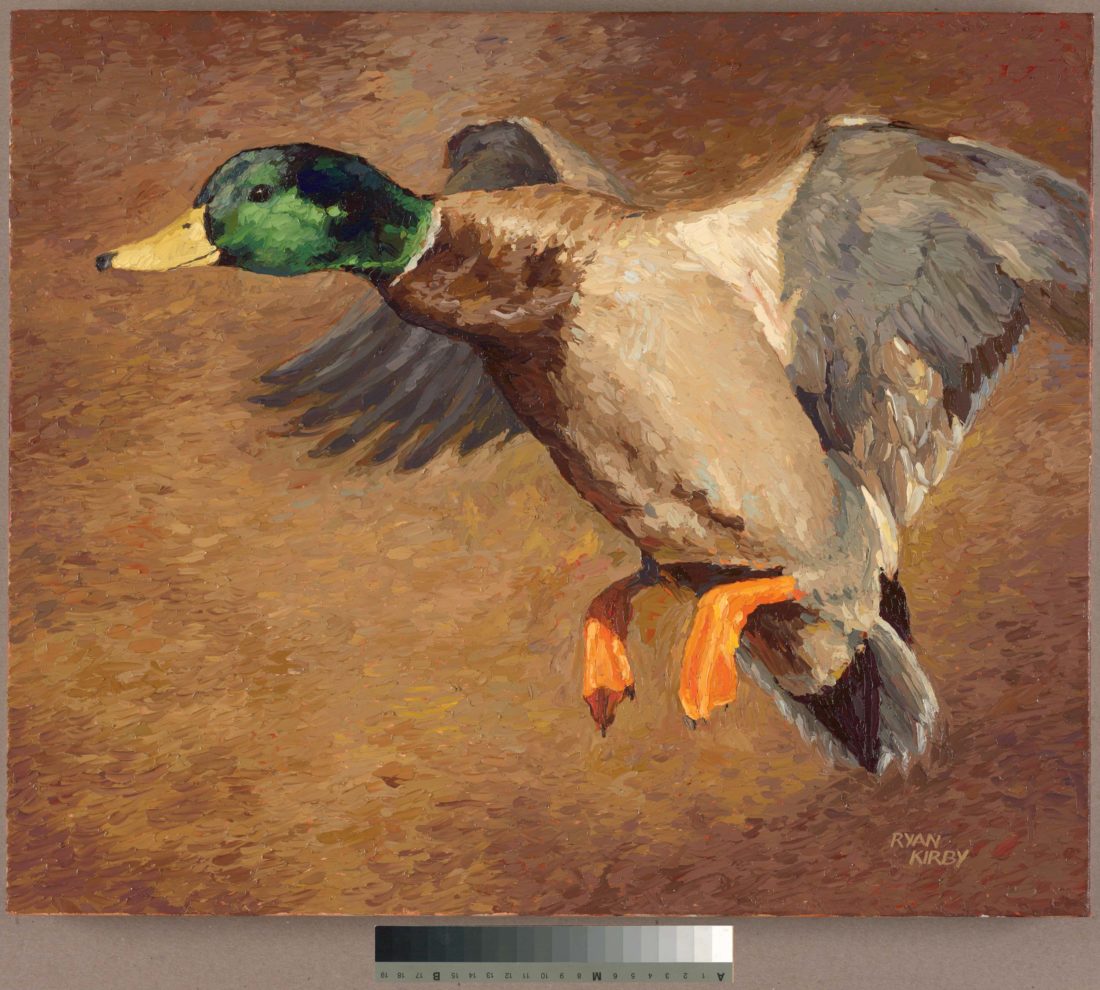
Cupped and Committed, oil on canvas, 2014
On our second morning after gobblers, Kirby and I park near an old hog barn covered in vines, and climb so high in the dawn light that the crows caw back and forth far below our hunting boots. A striped skunk saunters down the ridge twenty feet away. Warblers and towhees call, but the only gobbling tom rings from a ridge a mile away.
It’s hardly a wasted sunrise. Walking downhill, Kirby suddenly steps off the trail and pulls a camera from his turkey vest. On his knees, he photographs the scene ahead: a bit of a hill, a rock washed with sunlight, a pasture half in shade. He shows me the scene in the camera’s viewfinder. “Your eyes are really drawn to this rock,” he explains, “but the land just swoops away, so you can tell there’s a lot of elevation here. You can’t see all the mountains, but this one pasture and that rock have a lot of story. And that’s before I even think about where a turkey might go.”
Thinking of where a turkey might go—on a canvas, not in the woods—can be all-consuming for Kirby some days, but he is careful, he says, to focus on the work his art can do as much as the works of art themselves. As Kirby’s rise in stature has opened new doors, it’s also given him a new perspective on how a modern wildlife artist can interact with a world much broader than collectors. He recently completed a project for the Grandfather Mountain Stewardship Foundation—a portrait of two young cougars orphaned in the wilds of Idaho that were brought to the foundation’s mountaintop preserve in North Carolina. The cougars will live out their days in one of the state’s most iconic landscapes, and the funds raised from Kirby’s work will help pay for food and medical care for the big cats.
“I love to see my work doing good in the world, and I wonder: What if this not only increases, but increases exponentially?” he asks. “There’s an opportunity now in wildlife art to do something special that lives long after you’re gone. I’m not saying I’m at the top, but I’m thirty-six years old and already my work has raised more than a million dollars for conservation. There’s a lot of days when I’m like: Dang. Is this real?”
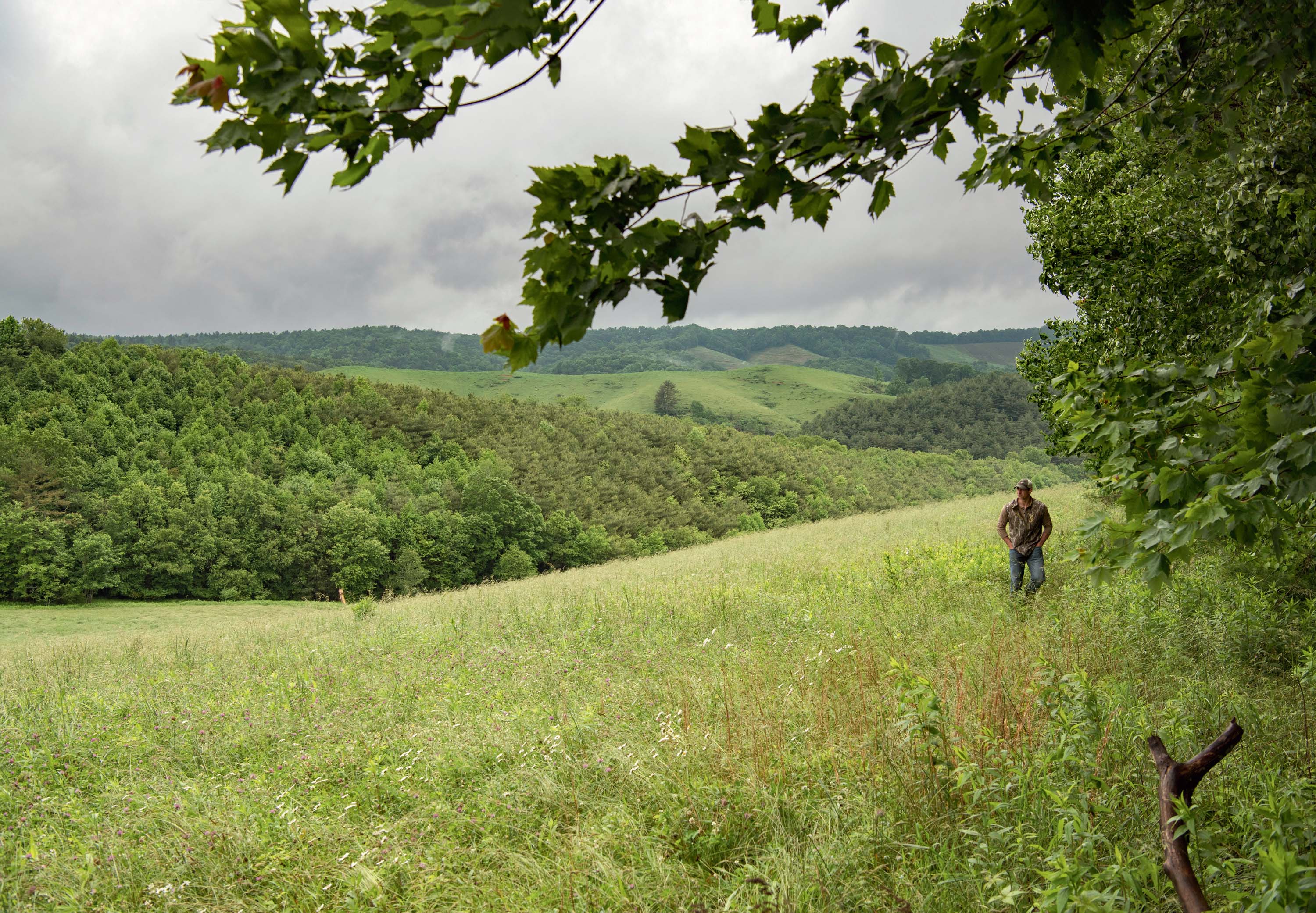
Photo: Andrew Kornylak
Ridges and valleys spread across the landscape outside Boone.
In the Kirbys’ living room, a painting of wild turkeys emerging over a fog-shrouded Appalachian ridge hangs near a soaring stone fireplace. I’d seen it earlier and was struck by the scene of this ridge awash in a gray brume. After our morning hunt, I step over for a closer study.
The misty scene carries the hint, and the promise, of much that remains unrevealed. The mind fills in the missing details, and the imagination rounds out the story, and it occurs to me that the entire painting speaks of something not quite in the clear, that the main action lies beyond its borders. In the painting, a tom turkey is caught in full-throated gobble, neck extended, wings braced for the recoil involved in this outburst of energy. Three hens cluster around the tom, but none are looking at the gobbler. They gaze off in different directions, wary, focused on the indistinct world beyond. Something else is going on outside the frame, something weightier than the tom’s challenging cry.
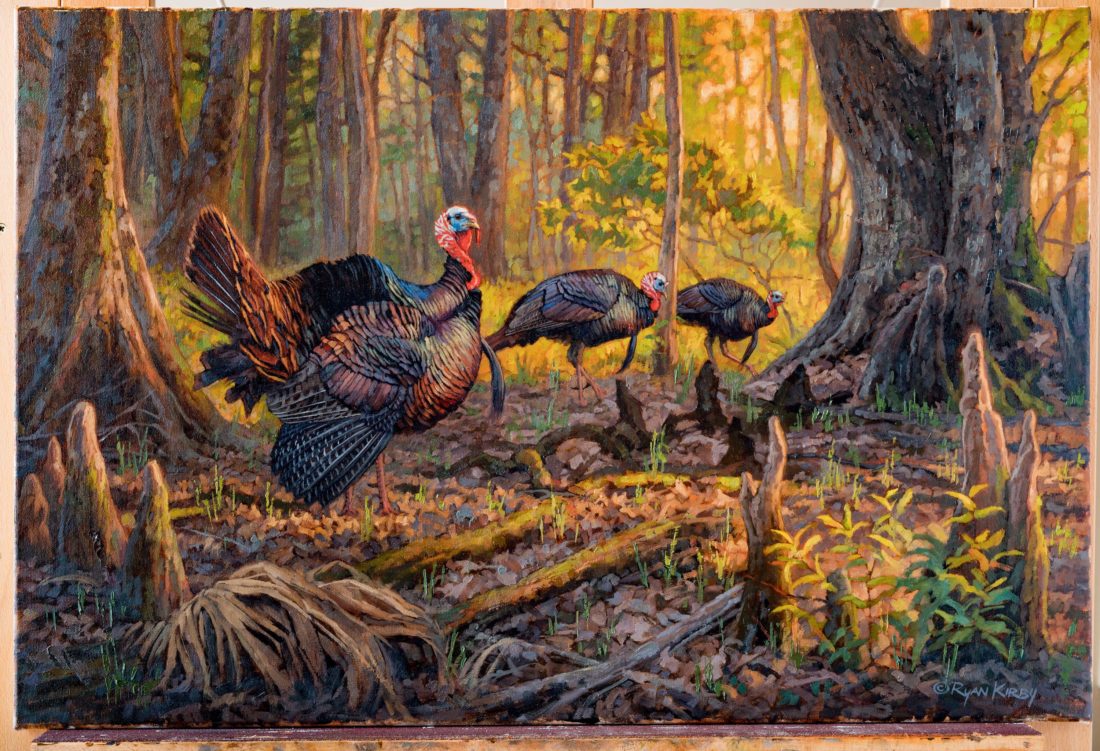
Cypress Sunrise, oil on canvas, 2018.
It brings to mind something Kirby had said earlier about how he approaches his work. One of his paintings might hang on a wall for forty years, and decades after he sells it he wants people to see things they hadn’t noticed before, interpret them in ways they might not have when they were younger.
“I do like to leave some things unsaid,” he tells me, “so my work can be a continual source of inspiration and imagination the whole time that sucker is hanging on the wall.
“This might sound a little deep,” he continues, “but it’s the truth: Every painting is sort of a projection of every experience I’ve ever had outdoors—every turkey gobble, every sunrise. All those things show up on the canvas, whether I’m thinking about them or not. That’s why I feel like I’ll paint my best in my fifties and sixties, because the more I can accumulate, not just in my head, but in my heart, the more I’ll have to say on canvas with each passing year.”
And perhaps, with each passing day. The next morning, we hunt hard northeast of the great bulwark of Grandfather Mountain, but most gobblers in the late season have assembled their harems and have little reason to answer a challenge. It’s nearly noon when we pull off the road to an old mountain homeplace, our last-minute, last-ditch try at a bird. Pulling shotguns from the truck, we hear a turkey gobbling wildly. Kirby’s grin says it all: A hot bird at midday is surely a lonely customer.
We course across a steep slope through tall white pines, tracking the turkey by ear, and when we first glimpse him, we know we have little time to spare. He strides purposefully down a slope of green pasture, which narrows to big woods. We move parallel, hidden in timber, and when the turkey disappears into a midfield gulch, we make our move: Kirby drops down by a tree twenty feet inside the wood line and clucks softly with a mouth call. I commandeer a pine on the field edge. Unseen, the bird gobbles like mad, closer still, searching for the hen. When he emerges from the gulch, he’ll either storm up the field to me, or sneak along the woods toward Kirby.
When he steps into the clear, I have a long forty-five-yard shot, but he’s angling toward Kirby, who’s posted up thirty yards off my right shoulder. I watch him close the distance, his fan spread wide as he passes behind a trio of red oaks and disappears. I can hear him spit and drum, a guttural, insistent sound that’s rarely heard unless a strutting gobbler is very, very close. I see Kirby’s finger creeping toward the shotgun safety, and then curling around the trigger, and in the next moment it’s over. All but the part where the artist makes it live forever.

